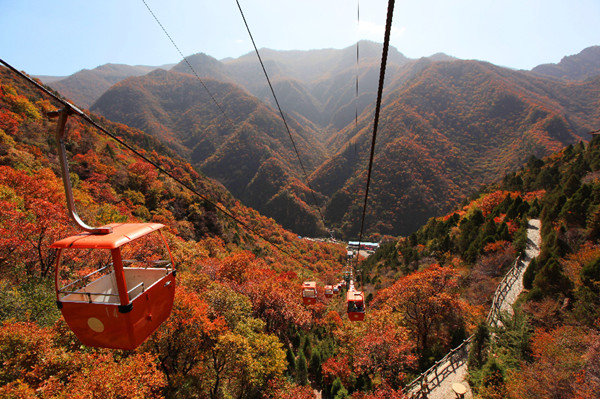 |
|
In autumn, visitors can take a cable car to get to the top while enjoy the wonderful scenery of red leaves covering the mountain. [Photo/Xinhua] |
A beautiful combination
It can be said that the Mianshan region has lost some of its charm due to the new roads that were built to accommodate tourists. Cars whizz along the winding mountain roads, sometimes speeding through tunnels and sometimes taking a sudden turn. According to locals, in the past there were only unsurfaced, narrow trails for people to access the temples and pay their respects to Buddha. The roads around Mianshan are now wide enough for two coaches to pass one another safely. This is more convenient for tourists, who can be brought directly to the foot of the hill where Zhengguo Temple is located, for example. However, to reach the temple, visitors still have to climb hundreds of steps or they can pay RMB 15 to take a lift to the temple entrance.
Tourism developers built a 180-meter-high hidden lift inside the mountain. Visitors taking the lift for the first time will be amazed by its delicate design, which does not disrupt the harmony of the scenic spot, but enables travelers, especially the elderly and children, to go sightseeing, a perfect combination of modern engineering and traditional architecture.
Located on the hillside of Five Dragon Peak, Zhengguo Temple is unique in architectural form, consisting of two parallel halls for worshipping Buddhist relics and the clay-encased bodies of eminent monks and Taoist priests, as well as the Ling-ying Pagoda.
With the cliff as its backdrop, Lingying Pagoda was built during the reign of Emperor Taizong (598-649) of the Tang Dynasty. The 69-meter-high pagoda consists of seven floors above ground and two floors underground. It is a Mianshan Mountain landmark. Destroyed by Japanese invaders in 1940, it was rebuilt in 2003 as an octagonal Buddhist Pagoda according to its original design. Its inner space is compact, with two wooden ladders connecting two floors.
The illuminating, panoramic and peaceful view at the summit is reward enough for the steep climb. Wulongchan, or Five Dragons' Traces, is named after the five dragons that, in folklore, following a sermon by the Buddha, took off into the sky, carving five gullies in the cliff.
The value of a scenic spot should not be judged by its tourist numbers, but by the spiritual worth and cultural experience it offers. Of course, accessibility to such places is of paramount importance in being able to reach such enlightenment, so the combination of the two – natural beauty and human practicality – as embodied by Mianshan, makes the mountain well worth a visit.